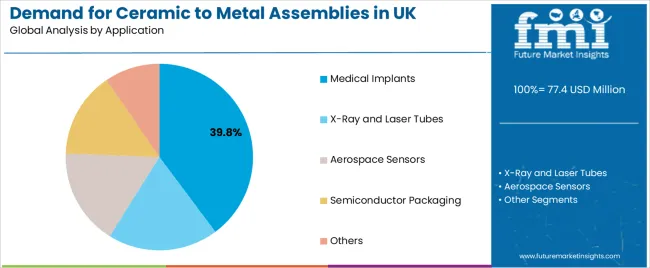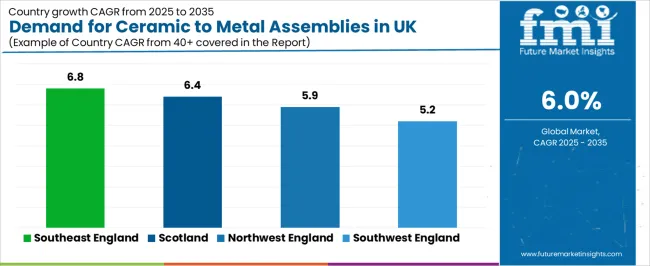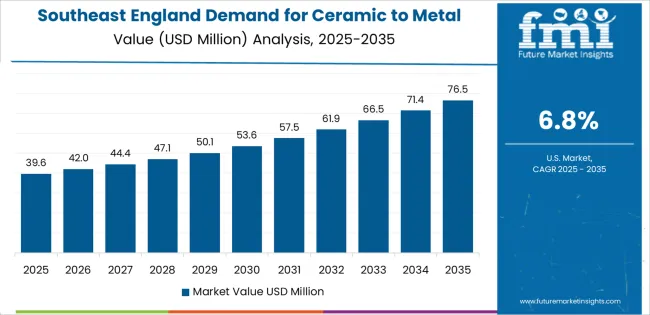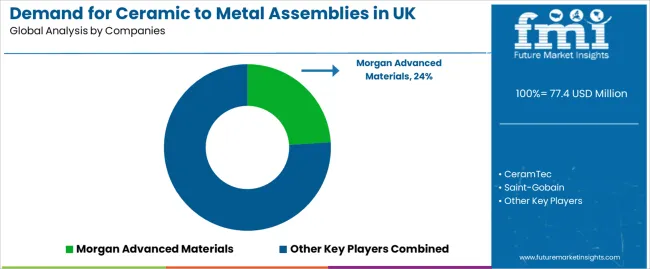Demand for ceramic to metal assemblies in the UK is projected to increase from USD 77.4 million in 2025 to USD 138.6 million by 2035, reflecting a total growth of 79.1% at a CAGR of 6%. Growth in sales of ceramic-to-metal assemblies is supported by expanding medical device manufacturing, rising semiconductor packaging requirements, and increased adoption of precision assembly systems in aerospace and advanced electronics applications. UK remains well-positioned due to its strong base of precision engineering talent, regulatory alignment with global medical standards, and established research capacity in materials integration and biomedical device development.
Demand for ceramic to metal assemblies in the UK is expected to reach USD 103.5 million, which accounts for 42.7% of total decade growth. This stage will be influenced by biomedical engineering development and regulatory compliance advancements driving greater adoption of ceramic-metal bond structures in implantable devices. From 2030 to 2035, demand is projected to increase to USD 138.6 million, contributing the remaining 57.3% of growth, driven by semiconductor packaging expansion, performance-critical aerospace sensor integration, and automated quality monitoring in device assembly environments. Zirconia-based ceramic to metal assemblies will hold the largest share at 42.3% due to biocompatibility and mechanical reliability advantages. Medical implants represent 39.8% of demand, reflecting regulatory priorities and long-term performance requirements. Regionally, Southeast England leads growth with a CAGR of 6.8%, followed by Scotland at 6.4%. Key suppliers include Morgan Advanced Materials, CeramTec, Saint-Gobain, Hermetic Solutions Group, and CoorsTek. Manufacturers in the cermaic to metal assemblies industry in the UK compete on materials science capability, precision manufacturing support, and regulatory alignment expertise.

Increasing integration of advanced electronic packaging systems in commercial aerospace applications and growing adoption of precision joining technologies continue to drive demand. Medical device manufacturers are expanding their assembly capabilities to address the growing complexity of modern implantable device requirements and certification specifications, with UK operations leading investments in biocompatible assembly systems.
From 2030 to 2035, demand is forecast to grow from USD 103.5 million to USD 138.6 million, adding another USD 35.1 million, which constitutes 57.3% of the overall ten-year expansion. This period is expected to be characterized by expansion of next-generation semiconductor packaging technologies, integration of automated assembly systems and quality control networks, and development of specialized joining pathways across different manufacturing applications. The growing adoption of thermal management principles and enhanced performance requirements, particularly in Southeast England and Scotland regions, will drive demand for more sophisticated assembly systems and specialized material combinations.
Between 2020 and 2025, UK ceramic to metal assembly demand experienced steady expansion, driven by increasing precision manufacturing requirements in medical device sectors and growing awareness of assembly benefits for biocompatibility and system reliability improvement. The sector developed as medical device manufacturers and electronics companies, especially in major technology centers, recognized the need for proven joining solutions and reliable material integration to achieve operational targets while meeting regulatory compliance expectations and quality certification requirements. Equipment suppliers and assembly manufacturers began emphasizing proper performance optimization and application integration to maintain operational efficiency and commercial viability.
| Metric | Value |
|---|---|
| UK Ceramic to Metal Assemblies Sales Value (2025) | USD 77.4 million |
| UK Ceramic to Metal Assemblies Forecast Value (2035) | USD 138.6 million |
| UK Ceramic to Metal Assemblies Forecast CAGR (2025-2035) | 6% |
Demand expansion is being supported by the accelerating emphasis on medical device manufacturing precision and biocompatibility standards nationwide, with UK maintaining its position as a medical technology innovation and precision engineering leadership region, and the corresponding need for effective ceramic-metal bonding systems for implantable device development, thermal management applications, and regulatory compliance integration. Modern medical device manufacturers rely on ceramic to metal assembly technologies to ensure operational competitiveness, quality certification, and optimal pathway achievement toward biocompatible manufacturing operations. Advanced electronic packaging requirements necessitate comprehensive joining solutions including specialized material processing, thermal cycling capabilities, and performance optimization infrastructure to address diverse application needs and specification requirements.
The growing emphasis on aerospace sensor development and increasing medical device manufacturing regulations, particularly biocompatibility commitments across UK, are driving demand for assembly systems from proven materials suppliers with appropriate joining expertise and quality management capabilities. Medical device manufacturers and electronics companies are increasingly investing in assembly technology sourcing and integrated material solutions to enhance operational profiles, access thermal management trends, and demonstrate engineering leadership in competitive medical technology environments. Manufacturing policies and regulatory compliance requirements are establishing standardized joining pathways that require ceramic-metal assembly systems and performance assurance, with UK medical device operations often pioneering large-scale implementation of advanced assembly technologies.
The ceramic to metal assemblies demand in UK is positioned for consistent expansion, growing from USD 77.4 million in 2025 to USD 138.6 million by 2035, reflecting a 6% CAGR. Rising adoption of biocompatible assembly systems in medical device manufacturing, aerospace sensor applications, and electronic component production is driving growth as manufacturers seek precision joining solutions that maximize performance and comply with stringent regulatory standards. Additionally, demand from semiconductor packaging applications and specialized industrial equipment strengthens opportunities for both advanced material formulations and automated assembly solutions.
Manufacturers focusing on zirconia-based assemblies, biocompatible joining systems, and process integration capabilities stand to gain from evolving manufacturing standards and customer expectations for material compatibility, reliability, and performance optimization.
Medical device manufacturers face increasing demands for biocompatible assembly solutions in implantable device production. Ceramic to metal assemblies enable precise material integration and long-term biocompatibility without compromising device functionality. Solutions targeting orthopedic implants, cardiovascular devices, and surgical instrument applications can achieve strong adoption rates through enhanced biocompatibility and regulatory compliance. Estimated revenue opportunity: USD 18.6--27.9 million.
The growth in aerospace sensor systems, satellite technology, and defense equipment creates robust demand for ceramic to metal assemblies ensuring precision in extreme environmental conditions. Manufacturers offering hermetic sealing solutions for aerospace applications can build relationships with defense contractors and satellite system suppliers. Estimated revenue opportunity: USD 12.4--18.6 million.
Medical device manufacturers are increasingly adopting automated joining systems for consistent assembly quality. Collaborations with equipment manufacturers for integrated assembly solutions can unlock large-volume supply contracts and long-term partnerships in precision manufacturing applications. Estimated revenue opportunity: USD 11.1--16.7 million.
Advanced material requirements and biocompatibility specifications are driving preference for zirconia-based assemblies with superior mechanical properties. Suppliers offering high-performance zirconia assemblies with enhanced joining effectiveness can differentiate offerings and attract quality-focused manufacturers. Estimated revenue opportunity: USD 14--21 million.
Critical medical applications require specialized ceramic to metal assemblies with exceptional purity levels and enhanced biocompatibility characteristics. Manufacturers investing in ultra-pure assembly development can secure advantages in serving performance-critical medical device applications. Estimated revenue opportunity: USD 10.5--15.8 million.
Comprehensive service networks offering installation, validation, and regulatory support create recurring revenue opportunities. Companies building strong technical support capabilities can capture ongoing relationships and enhance customer satisfaction across medical device manufacturing facilities. Estimated revenue opportunity: USD 8.1--12.2 million.
Demand is segmented by type, application, and region. By type, sales are divided into zirconia assemblies, alumina assemblies, aluminum nitride assemblies, and other ceramic formulations. In terms of application, sales are segmented into medical implants, X-ray and laser tubes, aerospace sensors, semiconductor packaging, and others. Regionally, demand is divided into Southeast England, Scotland, Northwest England, and Southwest England, with Southeast England representing a key growth and innovation hub for ceramic to metal assembly technologies.

The zirconia assemblies segment is projected to account for 42.3% of UK ceramic to metal assembly demand in 2025, making it the leading type category across the sector. This dominance reflects the biocompatibility advantages and mechanical performance of zirconia-based assembly systems for existing medical device manufacturing facilities and precision applications where material integration is optimized through proven ceramic-metal joining processes. In UK, where substantial medical device manufacturing infrastructure requires assembly integration without complete process replacement, zirconia systems provide practical pathways for biocompatibility enhancement while maintaining regulatory compliance continuity. Continuous innovations are improving joining effectiveness, thermal cycling characteristics, and biocompatibility parameters, enabling manufacturers to achieve high performance standards while minimizing biological impact. The segment's strong position is reinforced by the extensive existing medical device infrastructure requiring assembly adoption and growing availability of zirconia assembly technology suppliers with proven commercial experience.

Medical implant applications are expected to represent 39.8% of UK ceramic to metal assembly demand in 2025, highlighting the critical importance of implantable device development requiring specialized biocompatible joining solutions. Medical device facilities including orthopedic implant manufacturers, cardiovascular device producers, specialty processing, and commercial manufacturing applications generate consistent demand for assembly systems that are technically and economically favorable for biocompatible joining applications. The segment benefits from assembly characteristics that often provide superior biocompatibility compared to conventional joining alternatives, reducing regulatory complexity and costs. Medical implant manufacturing also accesses enhanced performance through material integration positioning that improve device reliability and clinical appeal. In UK, where medical device manufacturing innovation represents substantial portions of healthcare technology development, biocompatible assembly deployment requires ceramic to metal assembly integration across diverse medical device operations. In Southeast England and Scotland regions, where medical technology concentrations are significant, ceramic to metal assembly demand is elevated by emphasis on maintaining operational excellence while achieving biocompatibility integration targets.
UK ceramic to metal assembly demand is advancing steadily due to increasing medical device manufacturing precision and growing recognition of biocompatible assembly necessity for healthcare technology development, with Southeast England region serving as a key driver of innovation and application development. The sector faces challenges including competition from alternative joining technologies, need for specialized material handling infrastructure development, and ongoing concerns regarding process integration complexity and cost considerations. Medical device manufacturing guidelines and regional precision initiatives, particularly biocompatibility programs in Southeast England and Scotland regions, continue to influence assembly technology selection and deployment timelines.
The enhancement of medical device manufacturing regulations, gaining particular significance through healthcare industry biocompatibility guidelines and quality campaigns, is enabling assembly suppliers to achieve differentiation without prohibitive development costs, providing predictable demand patterns through manufacturing requirements and precision preferences. Enhanced biocompatibility standards offering substantial opportunities for ceramic-metal assembly systems and joining applications provide foundational dynamics while allowing suppliers to secure manufacturing agreements and application partnerships. These trends are particularly valuable for first-mover suppliers and premium assembly development that require substantial technology investments without immediate cost advantages.
Modern assembly suppliers and medical device manufacturers are establishing advanced quality control networks and centralized assembly management facilities that improve operational efficiency through joining standardization and economies of scale. Integration of automated assembly systems, real-time quality monitoring, and coordinated process management enables more efficient assembly operation across multiple manufacturing sources. Advanced assembly concepts also support next-generation medical device applications including specialized biocompatible integration, technology cluster optimization, and regional assembly supply networks that optimize system-level economics while enabling comprehensive quality control across medical device manufacturing regions, with UK developments increasingly adopting collaborative assembly models to reduce individual manufacturer costs and accelerate deployment.

| Region | CAGR (2025-2035) |
|---|---|
| Southeast England | 6.8% |
| Scotland | 6.4% |
| Northwest England | 5.9% |
| Southwest England | 5.2% |
UK ceramic to metal assembly demand is witnessing consistent growth, supported by rising medical device manufacturing precision, expanding biocompatible assembly requirements, and the deployment of advanced joining technologies across regions. Southeast England leads the nation with a 6.8% CAGR, reflecting progressive manufacturing trends, substantial medical technology innovation, and early adoption of premium assembly systems. Scotland follows with a 6.4% CAGR, driven by extensive precision manufacturing infrastructure, favorable technology demographics, and concentration of aerospace operations that enhance application development. Northwest England grows at 5.9%, as manufacturing modernization and technology efficiency opportunities increasingly drive assembly deployment. Southwest England demonstrates growth at 5.2%, supported by expanding aerospace facilities and regional manufacturing initiatives.
What Is the Demand for Ceramic to Metal Assemblies in Southeast England?

Demand for ceramic to metal assemblies in Southeast England is projected to exhibit exceptional growth with a CAGR of 6.8% through 2035, driven by progressive medical device manufacturing preferences, substantial technology development creating premium assembly opportunities, and concentration of innovation across London and surrounding counties. As the dominant region with extensive medical device infrastructure and precision-focused operational policies, Southeast England's emphasis on comprehensive manufacturing excellence and biocompatibility leadership is creating significant demand for advanced ceramic to metal assembly systems with proven performance and reliable application potential. Major medical device manufacturers and assembly suppliers are establishing comprehensive joining development programs to support technology innovation and premium assembly deployment across diverse applications.
How Is the Demand for Ceramic to Metal Assemblies Performing in Scotland?
Demand for ceramic to metal assemblies in Scotland is expanding at a CAGR of 6.4%, supported by extensive precision manufacturing facilities including aerospace applications, specialty processing, and technology establishments generating concentrated demand favorable for assembly systems. The region's operational characteristics, featuring substantial manufacturing operations and precision requirements ideal for assembly integration, provide natural advantages. Aerospace industry expertise concentrated in Glasgow, Edinburgh, and regional technology corridors facilitates application development and operational management. Assembly suppliers and manufacturers are implementing comprehensive joining strategies to serve expanding precision-focused requirements throughout Scotland.
What Are the Trends in the Demand for Ceramic to Metal Assemblies in Northwest England?
Demand for ceramic to metal assemblies in Northwest England is growing at a CAGR of 5.9%, driven by substantial manufacturing facilities from electronics operations, precision engineering, and regional technology requiring assembly pathways. The region's manufacturing base, supporting critical technology operations, is increasingly adopting assembly technologies to maintain competitiveness while meeting precision expectations. Manufacturers and assembly suppliers are investing in joining integration systems and regional supply infrastructure to address growing assembly management requirements.
How Is the Demand for Ceramic to Metal Assemblies Evolving in Southwest England?
Demand for ceramic to metal assemblies in Southwest England is advancing at a CAGR of 5.2%, supported by expanding aerospace manufacturing facilities, regional technology development including specialized applications, and growing emphasis on assembly solutions across the region. Manufacturing modernization and technology facility expansion are driving consideration of assembly systems as operational enhancement pathways. Technology companies and assembly suppliers are developing regional capabilities to support emerging assembly deployment requirements.

UK ceramic to metal assembly demand is defined by competition among specialized materials manufacturers, medical device equipment companies, and precision assembly providers, with major biocompatible assembly corporations maintaining significant influence through supply chain resources and technology development capabilities. Companies are investing in assembly technology advancement, supply chain optimization, distribution network structures, and comprehensive application services to deliver effective, reliable, and scalable ceramic-metal joining solutions across UK medical device manufacturing and precision applications. Strategic partnerships, technology infrastructure development, and first-mover application execution are central to strengthening competitive positioning and presence across medical implant manufacturing, aerospace sensor, and electronic component assembly applications.
Morgan Advanced Materials, internationally recognized materials leader, leads with 24% share, offering comprehensive ceramic to metal assembly supply including manufacturing, technology, and distribution services with focus on medical device applications, performance reliability, and cost optimization across UK operations. CeramTec, operating with extensive UK distribution, provides integrated biocompatible assembly solutions leveraging materials expertise, quality assurance development, and precision manufacturing capabilities.
Saint-Gobain delivers full-service ceramic to metal assembly processing including materials technology, performance testing, and supply management serving UK and international medical device projects. Hermetic Solutions Group emphasizes comprehensive sealing solutions with integrated assembly, quality control, and distribution capabilities leveraging medical device sector expertise. CoorsTek offers ceramic to metal assembly application development and quality assurance operations for manufacturing and precision applications across UK operations.
| Item | Value |
|---|---|
| Quantitative Units | USD 138.6 million |
| Type | Zirconia Assemblies, Alumina Assemblies, Aluminum Nitride Assemblies, Other Ceramic Formulations |
| Application | Medical Implants, X-Ray and Laser Tubes, Aerospace Sensors, Semiconductor Packaging, Others |
| Regions Covered | Southeast England, Scotland, Northwest England, Southwest England |
| Key Companies Profiled | Morgan Advanced Materials, CeramTec, Saint-Gobain, Hermetic Solutions Group, CoorsTek, KYOCERA, Materion, NGK, Murata, Microcertec |
| Additional Attributes | Sales by type and application segment, regional demand trends across Southeast England, Scotland, Northwest England, and Southwest England, competitive landscape with established materials suppliers and specialized assembly manufacturers, medical device operator preferences for zirconia versus alumina-based technologies, integration with manufacturing precision programs and biocompatibility policies particularly advanced in Southeast England region |
The global demand for ceramic to metal assemblies in uk is estimated to be valued at USD 77.4 million in 2025.
The market size for the demand for ceramic to metal assemblies in uk is projected to reach USD 138.6 million by 2035.
The demand for ceramic to metal assemblies in uk is expected to grow at a 6.0% CAGR between 2025 and 2035.
The key product types in demand for ceramic to metal assemblies in uk are zirconia assemblies, alumina assemblies, aluminum nitride assemblies and other ceramic formulations.
In terms of application, medical implants segment to command 39.8% share in the demand for ceramic to metal assemblies in uk in 2025.






Full Research Suite comprises of:
Market outlook & trends analysis
Interviews & case studies
Strategic recommendations
Vendor profiles & capabilities analysis
5-year forecasts
8 regions and 60+ country-level data splits
Market segment data splits
12 months of continuous data updates
DELIVERED AS:
PDF EXCEL ONLINE
Demand Side Management Market Size and Share Forecast Outlook 2025 to 2035
Demand Response Market Analysis - Size, Share, and Forecast Outlook 2025 to 2035
North America Shipping Supplies Market Trends – Innovations & Growth 2024-2034
Demand of Kozani Saffron in Greece Analysis - Size, Share & Forecast 2025 to 2035
Demand of No-acid Whey Strained Dairy Processing Concepts in European Union Size and Share Forecast Outlook 2025 to 2035
Demand for Bronte Pistachio in Italy Analysis - Size, Share & Forecast 2025 to 2035
Glycine Soja (Soybean) Seed Extract Market Size and Share Forecast Outlook 2025 to 2035
Demand and Trend Analysis of Yeast in Japan - Size, Share, and Forecast Outlook 2025 to 2035
Demand and Trends Analysis of Stevia in Japan Size and Share Forecast Outlook 2025 to 2035
Demand of Pistachio-based desserts & ingredients in France Analysis - Size, Share & Forecast 2025 to 2035
Japan Women’s Intimate Care Market Trends – Growth & Forecast 2024-2034
Western Europe Men’s Skincare Market Analysis – Forecast 2023-2033
Demand and Trend Analysis of Fabric Stain Remover in Korea Size and Share Forecast Outlook 2025 to 2035
Demand and Sales Analysis of Paper Cup in Japan Size and Share Forecast Outlook 2025 to 2035
Demand and Sales Analysis of Paper Cup in Korea Size and Share Forecast Outlook 2025 to 2035
Demand and Sales Analysis of Paper Cup in Western Europe Size and Share Forecast Outlook 2025 to 2035
Demand of MFGM-enriched Powders & RTDs in European Union Size and Share Forecast Outlook 2025 to 2035
Demand and Trend Analysis of Avocado Oil in Western europe Size and Share Forecast Outlook 2025 to 2035
Vanilla Bean Industry Analysis in Japan Size and Share Forecast Outlook 2025 to 2035
Banana Flour in Japan - Size and Share Forecast Outlook 2025 to 2035

Thank you!
You will receive an email from our Business Development Manager. Please be sure to check your SPAM/JUNK folder too.
Chat With
MaRIA